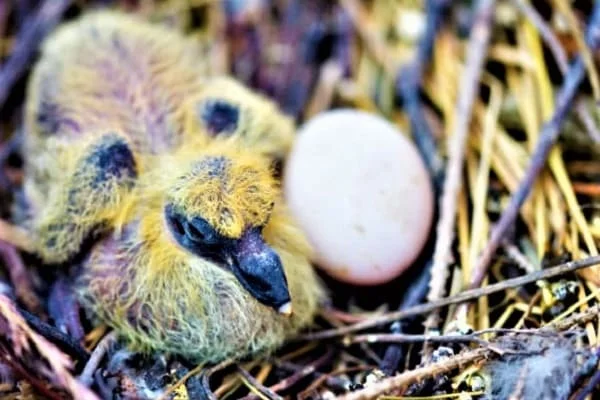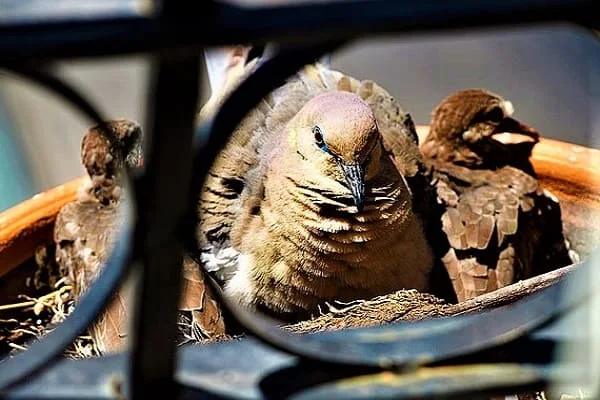Baby pigeons are almost everywhere and everywhere we go. Wild pigeons (rock doves) are always in abundance in the cities and baby pigeon in the countryside and urban areas.

Can baby pigeons survive without a mother?
Yes, little pigeons can only survive with their dads. This is because both parents are involved in raising the young, which essentially means that the male is equally capable of raising the young. This is, of course, a much more difficult job for an adult, but doable.
What does a dove look like?
But little is known about the appearance of their young, which is why we created this article to try and answer all common questions about pigeons along with some photos of pigeons.
Newborn pigeons have pink or dark skin and a minimal, uneven coat of yellow that will develop into feathers over time—sometimes it can be white. The beak, wings and legs are proportionately much larger than the body; however, these stats increase as they get larger. The beak is mostly pink, but maybe darker in color.
Legs slate grey. Babies are altricial, that is, they are born underdeveloped and need parental care and nutrition. Babies are born with their eyes closed. They also lie down, raise their heads, and open their accounts weekly.
How big is the pigeon?
A pigeon's eyes open when the baby is 4 to 5 days old. Generally, you'll never see a baby in this condition unless you're keeping pigeons indoors, or you've stumbled upon a pigeon den; however, this is unlikely as pigeons tend to be in high, secluded places place to nest. Most of the time, the first time we see young birds is at the youngster stage, which is basically the same as the old birds.
How much does a pigeon weigh?
Newborn pigeons are usually about 5 cm long. The average weight of newborn chicks is about 15 g. Pigeon chicks increase their weight from 4 to 8 grams per day, reaching a weight of 270 to 350 grams in 30 days.

Why can't you see little pigeons?
Small pigeons are rarely seen because they spend much more time in the nest than other birds (30 days on average). When they fly, their plumage is almost similar to that of adult birds.
They can be difficult to distinguish, but it is possible to do so. Another reason is that pigeons tend to nest in places that are completely out of the way. These are usually places like church spires, under bridges, chimneys and abandoned buildings in towns. Usually, we never see the actual pigeon nest, and in turn, we never see the chicks of the pigeons.
This tendency to nest highly instinctively comes from mountain pigeons. As the name suggests, Rock Pigeons usually nest on the edges of cliffs and usually retreat towards the face to protect the nests from any predators.
What does a young pigeon look like?
Young and fledgling pigeons are very similar in appearance to adult plumage, which is why many people are confused about the appearance of young pigeons. This is because they spend a lot of time in the nest, and when they fly away, they almost all have adult feathers. It varies between species of pigeons, but generally, the wax on young birds and chicks - the white coating on their beaks - will be pinker than the whites of adult pigeons.
They also lack the shimmery purple and green around the neck. Young pigeons under 8 months of age have medium brown or grey-brown eyes, while adults have yellow, orange or red-orange eyes. The feathers around the eyes may also appear darker than in adults. Runaway pigeons are much more common than you might think, so the next time you see a group of pigeons, be sure to look for young ones using the tips above.
What is the pigeon's name?
Pigeons are called pigeons. Squab is the term for a young immature pigeon that is too young to fly, usually under 4 weeks of age.
What do little pigeons eat?
Young pigeons are fed with regurgitation of goiter milk from both males and females. For the first 4 days, regurgitate it to the chicks within 2 hours of hatching. After that, they will continue to feed them with the collected milk and seeds for 5 days. Around day 9, the hatched pigeons will receive the adult feed.

- This includes seeds, fruits, and sometimes invertebrates. The amount of food given to young birds is increasing every day, especially when seeds are added.
- Both parents are required to breastfeed two children during the first week. After that, an adult can successfully feed two lovebirds.
- Goiter milk, also called pigeon milk, is a secretion from the mucous membrane of the crop (the "compartment" where birds can store food before it is digested). It is also extremely rich in fats and proteins.
What do pigeon eggs look like?
Pigeon eggs are small and white, with an average length of 38.4 mm and a width of 28.6 mm.
The average weight is 14.6 g. The thickness of the eggshell is about 0.18 mm.
How long does it take for a pigeon egg to hatch?
Eggs usually hatch 16 to 19 days after they are laid. Incubation occurs at any time of the day and takes approximately 24 hours. In most cases, both eggs hatch at the same time. The parents will remove the empty eggshells from the nest.
Both sexes share incubation duties, with the male typically incubating from mid-morning to the late evening, and the female form late evening to mid-morning. Pigeons usually breed year-round, so eggs can hatch year-round. On average, most pigeon chicks hatch in spring and summer, between May and June and August and November.
How do doves feed their young?
The adults return to the nursery to feed the babies, collecting milk, seeds, or any part of the diet, which they eat 3 to 4 times a day. Lovebirds are given the same amount of food each day.
Young pigeons call and may raise their heads to be fed by adults. After four days of age, young pigeons will call on their parents to get food and feed them. Young birds have been persistently begging and begging for food for about 7 days, when they usually feed twice a day.
When can small pigeons fly?
As a rule, young pigeons can fly at the age of about 6 weeks. But starting at 4 weeks old, they will start flapping their wings to start practicing and learning. At this time, you can often see how they take off and land on small elevations above the ground.
This is purely instinctive, as with all birds in flight, and occurs naturally shortly after the nest has feathered. Parent pigeons are very supportive as they learn to fly and will push their young to try and encourage them to move.
How long do doves stay in the nest?
The amount of time spent in the nest depends on the season. Usually it is from 25 to 32 days in summer, but in winter it can last up to 45 days. It is quite common for a newborn pigeon to lose weight in the first few weeks.
This is because they often get heavy before leaving the nest. Most young birds fly for a day or two and spend a few days on the ground foraging before being fully able to fly. In some cases, the pigeons will fly away, unable to return to the nest. This can happen when the nest is high and the chicks are not yet able to fly. If this happens, they often beg their parents and other adults for food.
Nests are usually built on internal ledges. It can be found in a wide variety of places, including caves, coastal cliffs, ravines, gutters, houses, barns, outbuildings, and even occasionally in tree cavities. The main requirement is a flat surface on a covered area.
Males usually choose a nest site, and when found, the female sits there while the male gathers materials to build the nest. The materials used are usually a mixture of twigs, branches, roots, straw, leaves, feathers, and many other materials. Once received, the male returns the material piece by piece to the female, who then puts it into her beak and places it on her chest or thigh, eventually building the nest.

- Pigeons often repurpose old nesting sites and usually build new nests on top of old ones. This is usually due to the accumulation of feces on the old nest.
- For this reason, 4-year-old nests can be up to 20 cm high and 50 cm wide. They can also weigh over 2kg and have cups up to 8cm deep.
How long do pigeons stay with their parents?
After birth, they usually spend 1 to 2 weeks in the vicinity of their parents' home.
What to do if you find a pigeon?
It is best to watch the plumage most of the time and keep pets away. Parents are often around and watching. Sometimes the presence of a person can scare the parents, so you won't be able to see them all the time - that's why it's important to keep an eye on them from afar.
Whether or not the pigeon appears injured initially, consider seeking advice from your local bird or wildlife rescue service. This is because they can determine if a bird needs rescuing. If the pigeon is in immediate danger, place it nearby in a sheltered and safe place.
Do pigeons mate for life?
Yes, pigeons mate for life. They are monogamous and tend to mate with one partner for life. If unfortunate happens and their partner dies, they usually find a new partner.
However, this may take some time and is not as fast as other birds.
leave builds nestlings developed brings afternoon substance newly molted feral pinkish flying songbirds fledge juvenile
